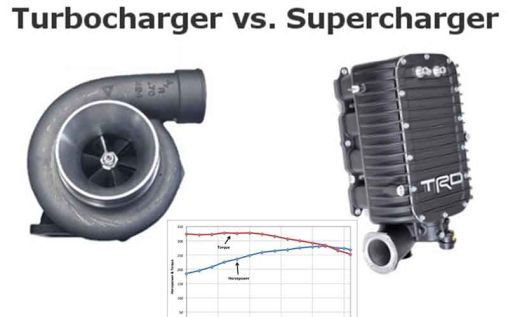What is Supercharging and Turbocharging and how it works
Posted by admin at 10 May 2014, at 21 : 39 PM

I know a lot of people on here probably already have a preference of either a supercharger or a turbo system, whether it’s single turbo or twin turbo. I want to talk a little about what exactly they are, and the pros and cons of both of them, and a little bit about naturally aspirated engines.
First of all for those that don’t know the function of supercharging or turbocharging, which is described by the term forced induction, it basically has to do with airflow. Don’t think about the fuel, think of an engine in terms of airflow. We know that air naturally flows from areas of higher concentration (pressure) to lower concentration (pressure). The whole goal is to get air to go from the induction system to flow to the cylinder head, then to the exhaust system in the best possible way.
Lots of people find it to be rather hard to get the kind of power they want from a naturally aspirated engine, which has to work within a maximum pressure variation of zero PSI and around 15 PSI (maximum atmospheric pressure at sea level). Both ends of the system start out at the same pressure, meaning air does not want to go in or out, which is the problem of how to flow air in and out of the Naturally Aspirated engine. In my idea it’s much easier to get the power you want with a forced induction engine, however, unlike most people with a favorite forced induction method, I think that in different situations one car can be more beneficial than the other.
Now I’ll explain how forced induction works, which will give you an idea how the supercharger and turbochargers get the engine to create more power, which is what we want. Rather than run an engine naturally aspirated, I see that pressurizing the intake system as easier, and better, as you don’t have to worry about the cam timing and all that stuff, and the air flows through perfectly. So the air this way will want to naturally go (flow) into the cylinder head, then leave through the exhaust system which is lower pressure after it’s all done. Turbos and superchargers both work the same, the only difference between a supercharger and a turbo is how the turbo gets its source of energy, and how it effects the exhaust manifold. Now I’ll go through the pros and cons of each system, since a turbocharger really is a supercharger in a sense, I’ll explain the supercharger first and then you’ll understand it better.
Superchargers are crank driven and use some of the energy (especially torque) from the engine to drive them. It directly pressurizes the engine on the induction side, where the pressures are highest. That is why the supercharger is a good choice instead of going naturally aspirated. Sometimes in a naturally aspirated engine, there is trouble with air flowing backwards. But in a supercharger all the effort doesn’t have to be made to keep the air flow going how it’s supposed to, like choosing a perfect exhaust system and a camshaft. Of course, supercharging has its drawbacks like using some of the torque that you’re trying to get to the wheels.
The turbocharger works exactly like the supercharger except it uses is recycled energy, from exhaust gases to power it. It keeps the torque from being sapped like the supercharger setup. So you are getting as much power as possible, and if you’ve ever noticed a turbo engine compared to a supercharged one, the turbo engine almost always has close to the same number of torque as horsepower, if not more, while the supercharged one usually has a bit less torque than horsepower. But just like a supercharger it has flaws. A turbocharger increases pressure in the exhaust system, which is not a good thing. We want the air to flow out easy, and it has a bad effect on that. So like a naturally aspirated engine, you’ve got to fool with the cam timing and exhaust.
I want to also talk about turbo lag. This is something that has been worked on and is improving, especially lately as technology has changed. But basically at low rpm’s it’s just you and the naturally aspirated horses while the turbos are building up with the pressure from the exhaust gases, while a supercharger has a directly driven compressor that isn’t effected by this problem. Most turbos only produce boost above a certain exhaust mass flow rate, and without a certain exhaust flow can’t force air into the engine.
I won’t get into what I think is the best, because I really believe that every situation is different, and depends on how you drive. I really have thought about both, when thinking about what I would get one day. I hope you enjoyed this post and come back soon.

